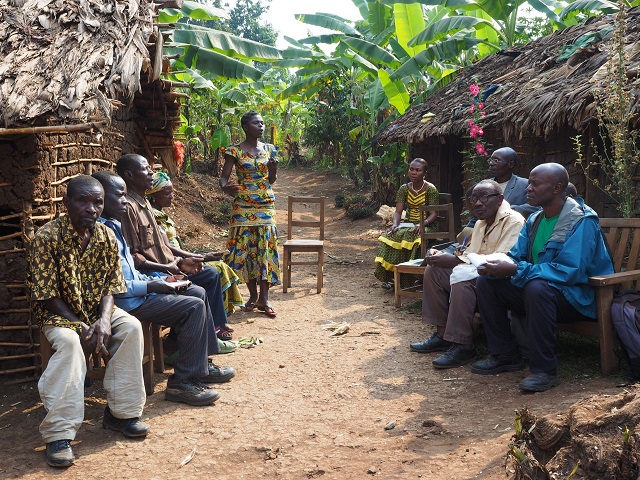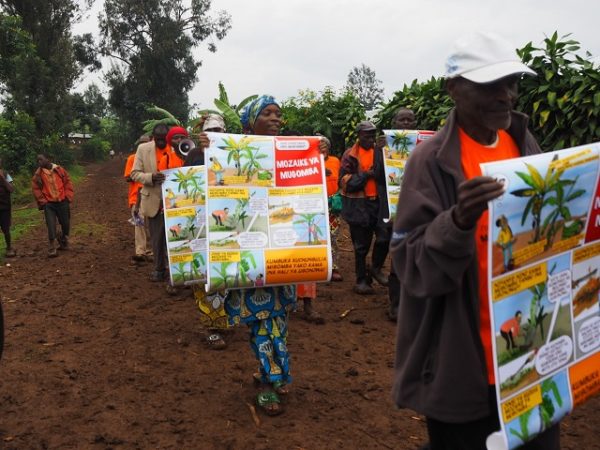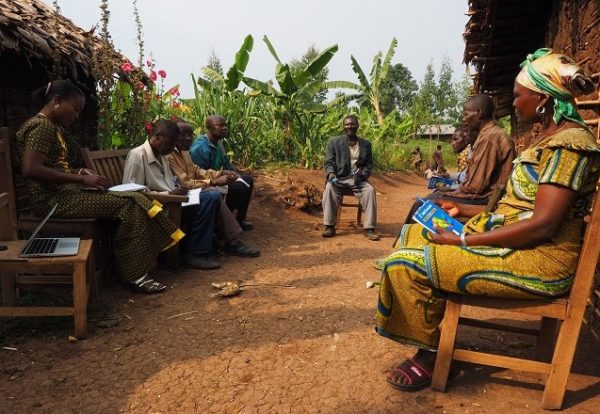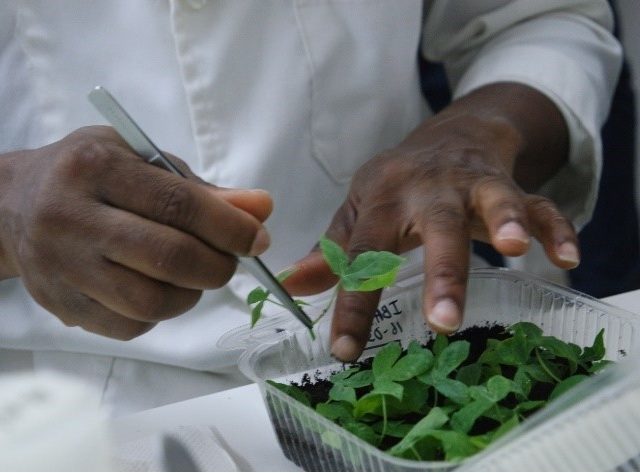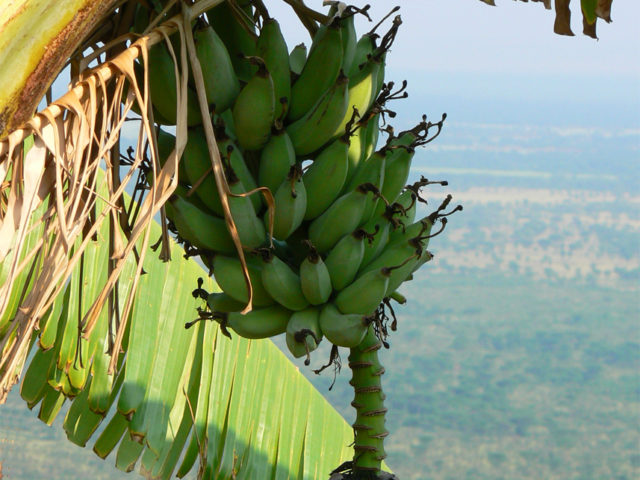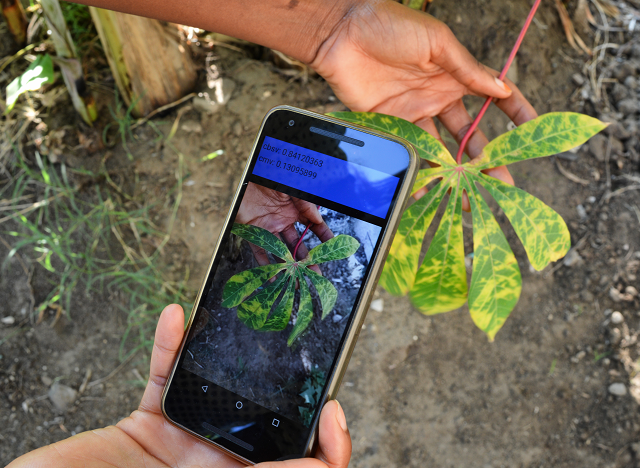The Institutional Learning and Change (ILAC) Initiative, in partnership with Bioversity International and with funds from the CGIAR Research Program on Roots, Tubers and Bananas (RTB) and the International Fund for Agricultural Development (IFAD), is working on a pilot transdisciplinary project in South Kivu, DR Congo aiming to control Banana Xanthomonas Wilt (BXW), a disease that is devastating banana production in central and eastern Africa.
Transdisciplinary Research: A pilot project in Congo[1]
by Javier Ekboir, Cristina Sette, Boudy van Schagen and Guy Blomme
Why transdisciplinary research? How different is it from other types of research?
With the new and evolving trends in research and development, the CGIAR needs to better understand and define what research for development (R4D) actually means in terms of new research frameworks and practices. For example, what does it mean for a plant pathologist to do R4D? What he/she should do differently from his/her traditional practice? In recent years several organizations have asked similar questions in many areas of research, including health, agriculture and physics, and they all have converged on the idea that they have to foster greater interaction among different stakeholders of research. Such approach is known as transdisciplinary research.
The table below explains the differences between transdisciplinary, multidisciplinary, and interdisciplinary research.
| Transdisciplinary Research | Multidisciplinary Research | Interdisciplinary Research |
| Collaboration in which exchanging information, altering discipline-specific approaches, sharing resources and integrating disciplines achieves a common scientific goal (Rosenberg 1992). | Researchers from a variety of disciplines work together at some point during a project, but have separate questions, separate conclusions, and disseminate in different journals. | Researchers interact with the goal of transferring knowledge from one discipline to another. Allows researchers to inform each other’s work and compare individual findings. |
Source: Transdisciplinary Research on Energetics and Cancer (TREC) Center at Washington University
Transdisciplinary research focuses on exploring different types of engagement, for example, when farmers are consulted and their needs and opinions are addressed, but they are not part of the research itself.
While the principles of transdisciplinary research are well known (see Frodeman, Thompson Klein and Mitcham 2012), it has been difficult to apply them in practice because transdisciplinary research is a complex process and as such requires adaptive management and strong learning capacities (Patton 2011).
The Institutional Learning and Change (ILAC) Initiative, with funds from the International Fund for Agricultural Development (IFAD) and CGIAR Research Program on Roots, Tubers and Bananas (RTB), in partnership with Bioversity International, have initiated a pilot project in two villages of the South Kivu province, DR Congo, aiming to control Banana Xanthomonas Wilt (BXW), a disease that is devastating banana production in central and eastern Africa.[2] In more detail, the project seeks to develop principles CGIAR can use to better conduct research for development, adapted to the particular features of each research project. The project’s technical and social goals are to
- develop new recommendations for the control of BXW that take into account the needs, constraints and possibilities of different types of farmers and new approaches for the diffusion of the recommendations among farmers
- explore whether a transdisciplinary approach leads to new agronomic, social and extension recommendations that accelerate uptake of research results
- identify principles for the implementation of transdisciplinary research in the context of agricultural research for development
What difference is it already making on the BXW project in Congo?
After a few months of implementation, the transdisciplinary project was able to refocus the initial agronomic and social science research questions on the basis of information generated in non-controlled experiments and anecdotal information.
Initially, the main research question that guided the agronomic research was “how low and how fast the incidence of BXW could be driven down by using a new control strategy, i.e., Single Diseased Stem Removal (SDSR)?”
With the epidemiological information available at the moment, the research team concluded that BXW could not be eradicated; therefore, it was necessary to develop a control strategy. It was initially assumed that BXW could not be controlled by individual farmers because bacteria would be permanently reintroduced from neighboring infected plots; therefore, collective action to prevent reinfections was needed. The first social science research question was “what are the most appropriate collective action interventions to control BXW in a village?”
The project team then decided to try three parallel but linked collective action interventions: creation of self-help groups, coordination of influential local actors (e.g., priests, pastors, chiefs and NGOs), and collaboration with established farmer organizations. Soon the agronomic experiments conducted by the two projects mentioned in the footnote clearly indicated that when SDSR is used properly, the incidence of BXW can be reduced to less than 2% of plants in about two months irrespective of the initial incidence level. This low level of incidence suggested that it might be possible for farmers to control the disease individually. The core team then posed a new agronomic research question “can farmers control BXW in their farms with SDSR irrespective of what their neighbors do?”
This question is essential for the design of control strategies. If farmers can control BXW individually, no collective action is needed and the agronomic recommendations and control programs are simpler.
In addition, the transdisciplinary team explored a third research question: “Can the small self-help groups provide rapid feedback on new agronomic, social and organizational recommendations for the control of BXW?”
As the project progressed, the team observed that the self-help groups did not work as expected: they did not catalyze farmer experimentation but they helped researchers to identify issues that had not been considered in the initial design of the transdisciplinary project and to adjust the research activities. Additionally, since the farmers in the groups did not use the whole control package as recommended (see below), their actions were seen as uncontrolled experiments that tested the flexibility of the recommendations. As all farmers were able to reduce the incidence to 2% or less, it was concluded that the recommendations could be greatly simplified. Originally, the recommendations included (a) cutting diseased plants weekly; (b) cutting the male bud; (c) preventing livestock from wandering freely in the banana plots; and (d) to allow livestock preventing the children from cutting banana leaves. The new recommendations were included only cutting the diseased stems at least once a month and disinfecting the cutting tool afterwards.[3] The simplification of the recommendations is particularly important because practices (c) and (d) created important social tensions as it is customary and children to move freely among the bananas.
As a conclusion, the rapid adaptation of the research questions was possible because (a) at the beginning of the transdisciplinary work there was already a wealth of knowledge about BXW, including the basis of a control strategy; (b) the agronomy and social experiments implemented by the team yielded responses in a few months, not years; and (c) the research team was explicitly seeking to identify emerging issues; as has been identified in the specialized literature, serendipity happens only when researchers have multiple selection criteria, and are flexible and opportunistic (Nickles 2003).
While transdisciplinary research can accelerate the generation and diffusion of appropriate research outputs, it cannot be mechanically imposed on teams, as the difficulties of using on-farm research and participatory research have shown. A critical factor in the integration of the teams is the combination of a “generalist”, a researcher that can talk different “languages” (disciplinary research, development with the NGOs and “livelihoods” with farmers) and strong disciplinary researchers. A team with only generalists lacks depth of knowledge; a team with only disciplinary researchers has difficulties in building shared communication codes. In addition to the individual scientific approaches, the creation of transdisciplinary depends on institutional settings and incentives (National Research Council 2014).
Next steps
The next steps to be taken in the project are the exploration of three emerging issues:
- Explore if redesigned self-help groups of farmers contribute to the dissemination of SDSR
- Engaging influential actors, especially large NGOs, to help disseminate SDSR
- Adapting the recommendations to different banana-based production systems; in particular, exploring how fast the incidence increases with less intensive controls
These recommendations are effective in high altitude areas where the insect population is small; additionally, in the research area there are few wandering animals. The recommendations will be tested in other areas with a different ecological and social environment.
[1] Adapted from: “Setting up a trans-disciplinary research team for the control of Banana Xanthomonas Wilt (BXW) in South Kivu Province, DRC” by Javier Ekboir, Boudy van Schagen and Guy Blomme
[2] The recommendation to cut at least once a month resulted from the behavior of the disease in the farms of the self-help members. This is being validated in experimental plots and with other farmers.
[3] The project builds on two previous projects that studied options for control of BXW in experimental plots. These projects are Transforming CIALCA into a Humidtropics platform in East and Central Africa – CIALCA+, and FAO-Food Security Risks in the Great Lakes Region – Rapid response to the threat of banana diseases.
For more information, please contact Javier Ekboir at j.ekboir@cgiar.org
